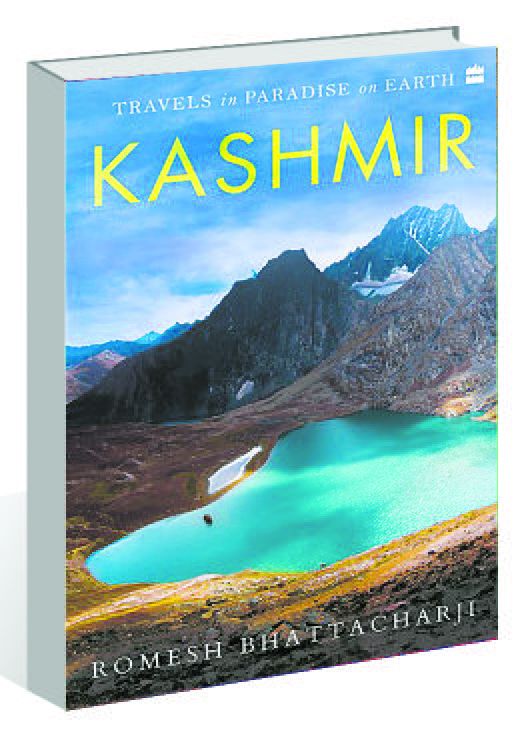Kashmir: Travels in Paradise on Earth by Romesh Bhattacharji. HarperCollins. Pages 241. Rs 599
Book Title: Kashmir: Travels in Paradise on Earth
Author: Romesh Bhattacharji
Manoj Joshi
Reams have been written on Kashmir and its beauty, but Romesh Bhattacharji brings an unusually intense view in his book. ‘Grand amateur’ is a French phrase that translates into being a ‘big fan’ in English. But the definition is only partial. In reality, a ‘grand amateur’ is a person whose passion for a subject or hobby takes him or her beyond ‘fandom’ to the level of an expert. There is little doubt that this is not the work of a mere travel writer or trekker, but someone who has a deep knowledge of the subject.
By profession, Bhattacharji is a retired Indian Revenue Service officer who served with distinction in a variety of roles — customs and excise, revenue intelligence and narcotics control. You will agree that these are not flamboyant jobs and are often characterised by dreary bureaucratic drill. But through his life, indeed beginning with St Stephen’s College where he studied in the early 1960s, the Meerut-born Bhattacharji nurtured his passion for the Himalayas.
An avid trekker and mountaineer, he has crisscrossed the mountains, developing nothing short of high expertise. This has been evident in his previous books on Ladakh and the North-east. ‘Kashmir’ is his latest book and even a cursory glance will show you that this is no ordinary travelogue, but a deeply detailed study of the region.
It traces almost all the corners of the paradise, district by district, mountain by mountain, in granular detail. What is striking is the level of description.
The book covers Kashmir’s mountain areas, its fabled valley and the famous Mughal Gardens. “Kashmir is unusual in that it has an abundance of easy and visually rewarding walks close to roadheads,” he says, noting that while the main roads and highways may have heavy traffic, the interiors remain less travelled and, of course, visually pleasing.
The mountain areas are described as 18 coherent blocks which can be used to work out travel plans that can be achieved by simply walking, trekking or travelling on a two-wheeler or in a car or local buses. These can provide joy to the average tourist, or if you go up towards the glaciers, an experienced trekker or mountaineer.
The Valley has a unique geological past in that it was probably a lake at one time which drained out slowly, leaving debris from springs which are 50-100 metre high plateaus that dot the 140 x 40 km Valley and are known as ‘karewas’. Srinagar airport is built on one such feature and, as Bhattacharji notes, almost all the famous saffron crops are grown on the ‘karewa’ of Pampore.
The book has covered all the Valley districts — Kupwara, Baramulla, Bandipora, Ganderbal, Srinagar, Budgam, Pulwama, Shopian, Anantnag and Kulgam. Despite its small size, the Valley offers an incredible variety of forests, fields and lakes. But perhaps what is most striking is the detailed description of the famous Mughal Gardens around Srinagar — Naseem, Shalimar, Nishat, Chashme Shahi and Pari Mahal. To this, the author adds spots where the Mughals developed gardens, such as the Achabal spring, or a spring which is one of the sources of the Jhelum river in Verinag.
There is an entire generation of Indians for whom Kashmir means violence and turmoil. But there was a time when Kashmir used to be a paradise for travellers, tourists, and, I dare say, its people themselves. Bhattacharji has occasionally alluded to violence. “Only in a couple of places have I given examples to emphasise that violence and beauty are two faces of the Kashmiri coin,” he notes wryly.
It would have been useful if the book had a good single map of the Kashmir area which displayed the locations of the mountain blocks described in relation to each other. As of now, it is difficult to figure out where the Pahalgam area ends and the neighbouring one begins. The ‘aerial’ view has been very shoddily printed, making it useless for the reader. The Mughal Garden maps, too, do not provide any annotation. However, given the reluctance with which publishers look at maps these days, we should be happy that as many as 36 have been printed, along with some photographs and sketches. It’s a testimony to the details packed in the book as well its handsome index, which is very useful in exploring Kashmir.














